Eyes and Vision
Full Sensory Theater
Only the 1960s would conceive of this. Full patent here.


Posted By: Paul - Wed Dec 18, 2024 -
Comments (2)
Category: Inventions, Patents, Movies, Television, 1960s, Eyes and Vision, Head, Smells and Odors
Bedding with viewing lenses
Patent No. 12,156,603 recently issued to Lillian A. Foucha of New Jersey. An explanation from the patent:
via Jeff Steck (bluesky)
Posted By: Alex - Mon Dec 09, 2024 -
Comments (3)
Category: Patents, Eyes and Vision
Louvered Sunglasses
Wouldn't you look chic wearing these? And no more viewing the world through "rose-colored glasses."Original patent here.


Posted By: Paul - Fri Oct 25, 2024 -
Comments (1)
Category: Inventions, Patents, 1950s, Eyes and Vision
The effect of humming on vision
A Dec 1967 article ("Effect of humming on vision") by William Rushton in the journal Nature reported that:I'm sure that's interesting, but it's a response to Rushton's article published four months later that I find more interesting. A former member of the Air Training Corps described how it was possible, by humming (or rather, "purring"), to make your head vibrate such that, when looking at a spinning propeller, the propeller would seem to stop in mid-air. By increasing or decreasing the intensity of humming/purring, one could then determine in which direction the propeller was rotating.
I haven't tested this out to see if it works, but if any of you do have a chance to test it out, please report back with your results.

Nature - Apr 20, 1968
Posted By: Alex - Fri Sep 27, 2024 -
Comments (2)
Category: Science, Air Travel and Airlines, 1960s, Eyes and Vision
Bomb Proof Eye Guards

Mechanix Illustrated - Mar 1941
Posted By: Alex - Wed Jul 10, 2024 -
Comments (1)
Category: War, Weapons, 1940s, Eyes and Vision
Smartphone-Shaped Sunglasses
Part of designer Sinead Gorey's "Phonecore" collection.More info: hmd.com

Posted By: Alex - Sun May 26, 2024 -
Comments (0)
Category: Fashion, Eyes and Vision
An Upside-Down Experiment
In 1950, graduate student Fred Snyder of the University of Wichita spent 30 days wearing special glasses that inverted his vision. It was part of an experiment designed by Dr. N.H. Pronko, head of the psychology department, to see if a person could adapt to seeing everything upside-down. The answer was that, yes, Snyder gradually adapted to inverted vision. And when the experiment ended he had to re-adapt to seeing the world right-side-up.Snyder and Pronko described the experiment in their 1952 book, Vision with Spatial Inversion. From the book's intro:
Such an experiment is out of the question, of course. Yet another experiment was made: a young man was persuaded to wear inverting lenses for 30 days, and his experiences are reported here. His continued progress, after an initial upset, suggests that new perceptions do develop in the same way as the original perceptions did. Life situations suggest the same thing. Dentists learn to work via a mirror in the patient's mouth until the action is automatic. In the early days of television, cameramen had to "pan" their cameras with a reversed view. Later the image in the camera was corrected to correspond with the scene being panned. The changeover caused considerable confusion to cameramen until they learned appropriate visual-motor coordinations. Fred Snyder, the subject of our upside-down experiment, found himself in a similar predicament, at least for a time.
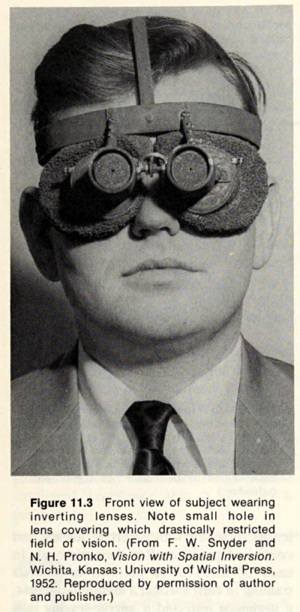
Images from Life - Sep 18, 1950:
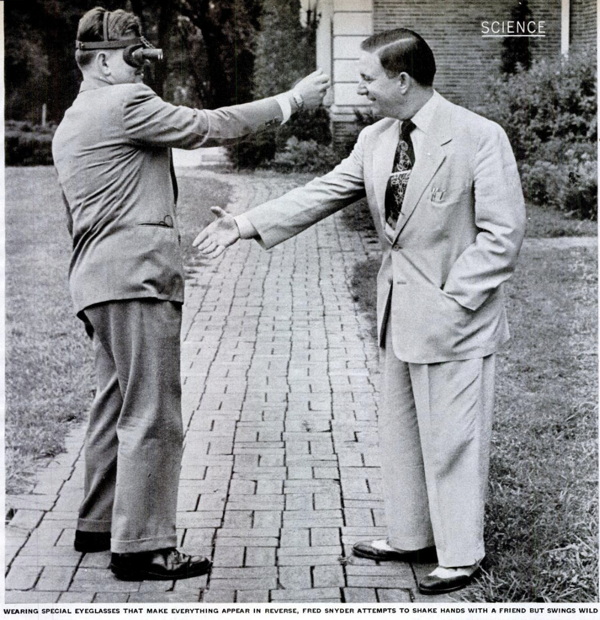
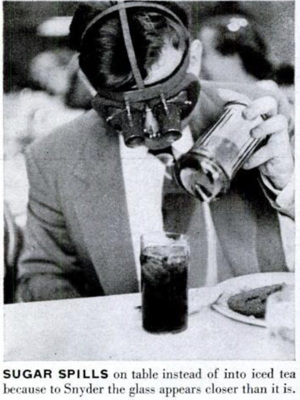
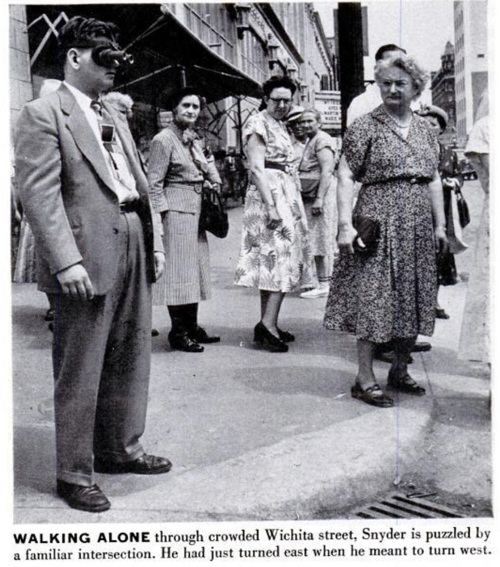
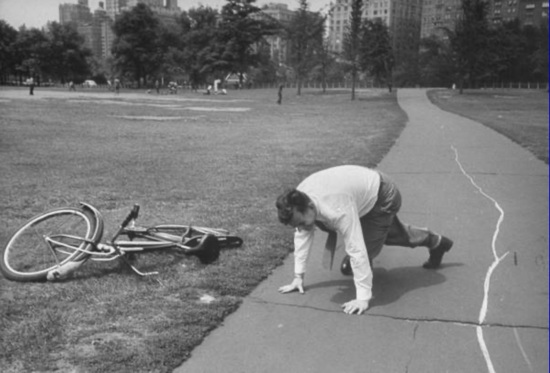
"Graduate student Fred Snyder falling down after removing special eyeglasses that reverse and invert everything he sees. Immediately before removing glasses he rode a bicycle with perfect control along sidewalk in Central Park."
Posted By: Alex - Mon Mar 25, 2024 -
Comments (2)
Category: Experiments, 1950s, Eyes and Vision
Heterochromatic Girl
AKA Norma Eberhardt. Her heterochromia was reportedly the trait that initially attracted the attention of a photographer, leading to a modeling (and later acting) career.Wikipedia has a list of other actors with heterochromia, but Eberhardt's condition was far more pronounced that most of the other people on the list.
More info: curator's cabinet


Posted By: Alex - Thu Oct 05, 2023 -
Comments (4)
Category: Actors, Eyes and Vision
Marty Snyder, the blind movie censor
Supreme Court Justice Potter Stewart famously said, when asked to define pornography, "I know it when I see it."Marty Snyder couldn't see it, but he figured he would know it anyway, especially if the person sitting next to him filled him in on what he was missing.
Snyder ended up serving on the Clarkstown censorship panel for less than a year because he died of a stroke in 1974.

South Mississippi Sun - Oct 25, 1973
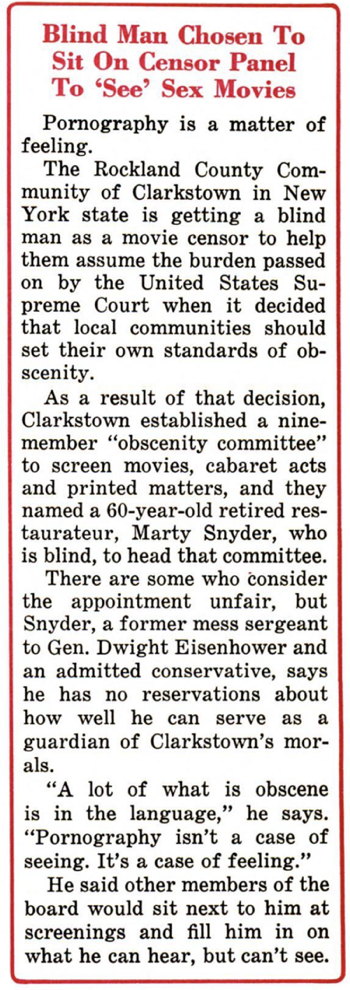
Posted By: Alex - Fri Aug 25, 2023 -
Comments (0)
Category: Censorship, Bluenoses, Taboos, Prohibitions and Other Cultural No-No’s, 1970s, Eyes and Vision
Driving Blind

London Daily Telegraph - Sep 5, 2006
Posted By: Alex - Tue Nov 29, 2022 -
Comments (5)
Category: 2000s, Eyes and Vision, Cars

| Who We Are |
|---|
| Alex Boese Alex is the creator and curator of the Museum of Hoaxes. He's also the author of various weird, non-fiction, science-themed books such as Elephants on Acid and Psychedelic Apes. Paul Di Filippo Paul has been paid to put weird ideas into fictional form for over thirty years, in his career as a noted science fiction writer. He has recently begun blogging on many curious topics with three fellow writers at The Inferior 4+1. Contact Us |




